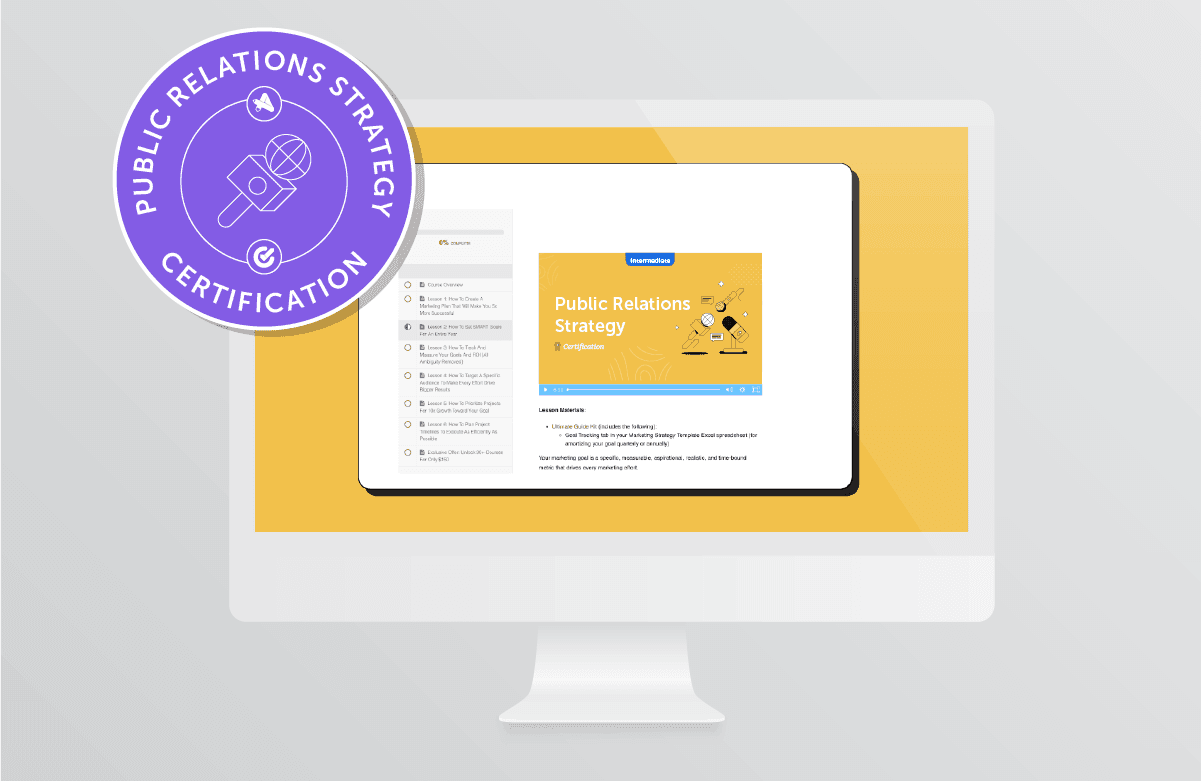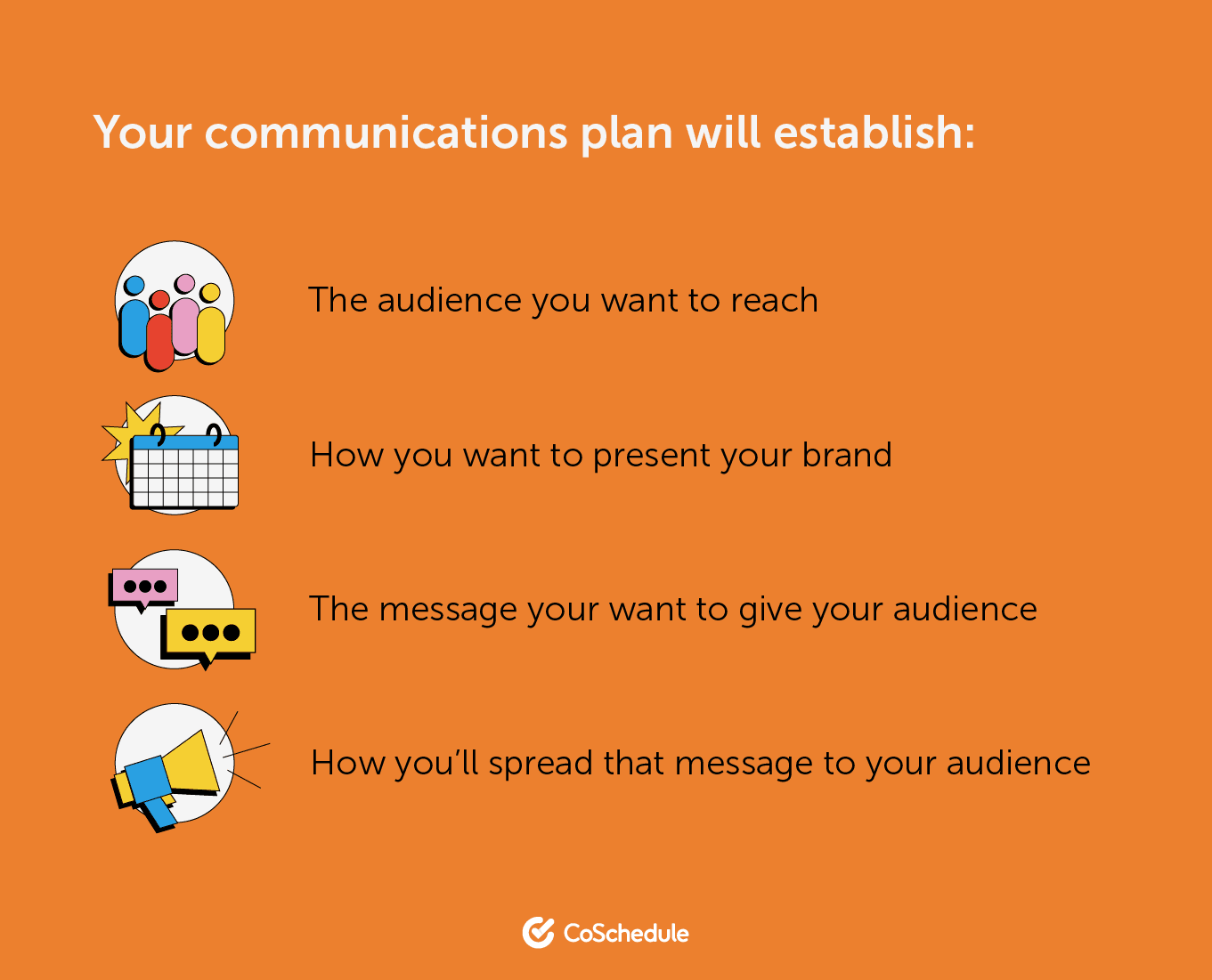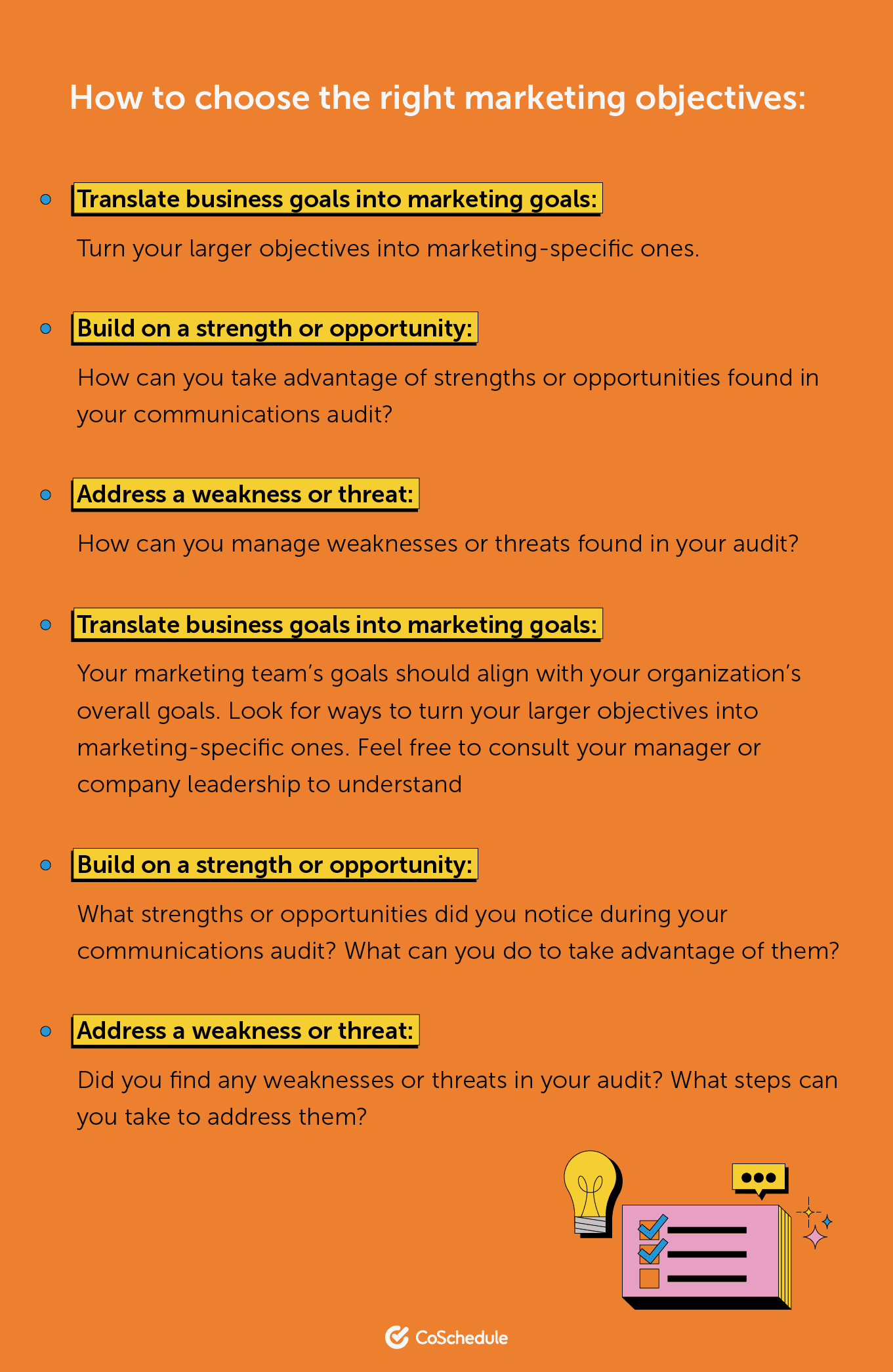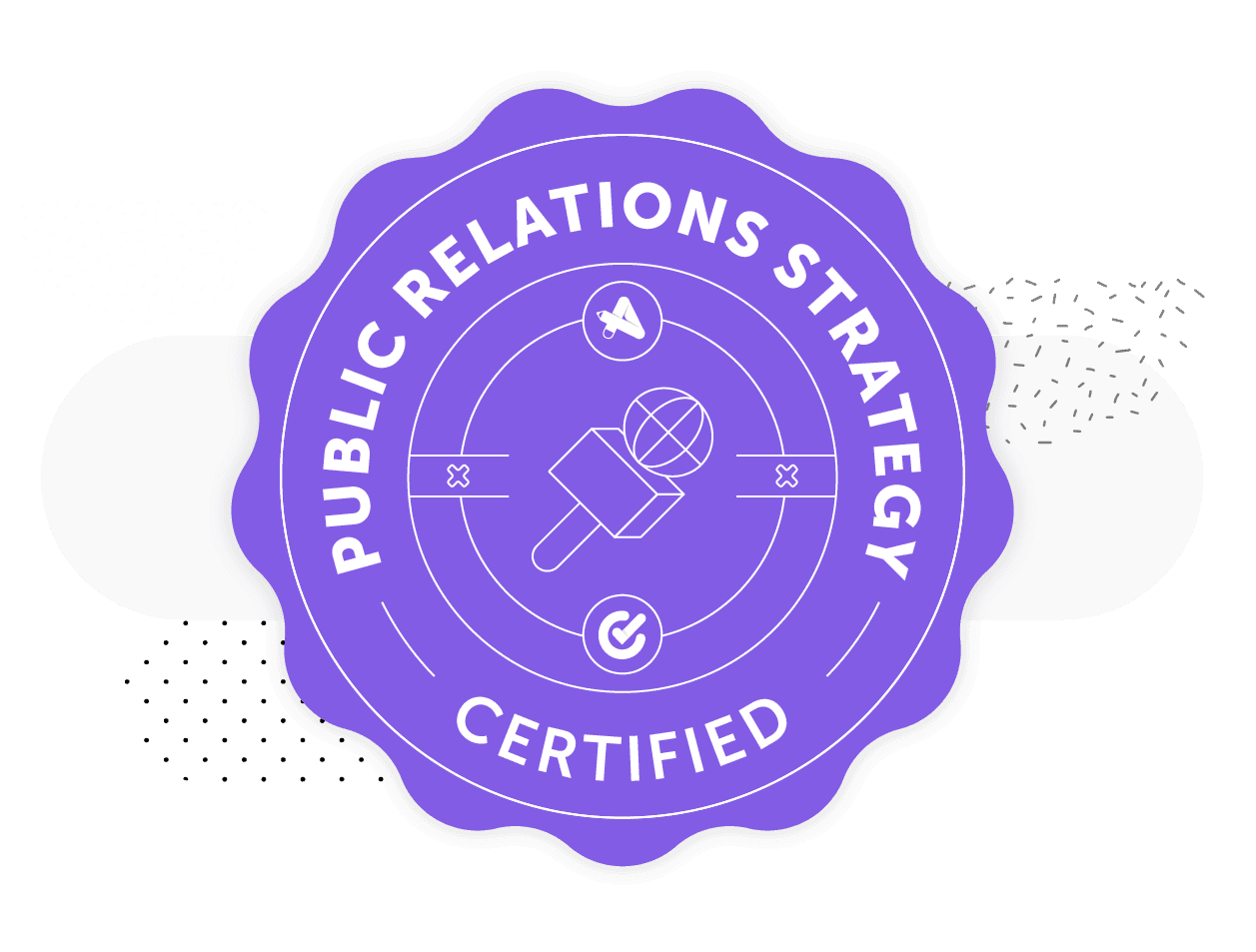How To Create A Communications Plan in 12 Steps (Free Template)
 Good marketing looks effortless, but it has an underlying structure — a communications plan. Every message in well-executed marketing is one moving part of a greater whole.
So, what goes into a communications plan, and how can you make one for your team? We’ll explain what this nifty resource is and the 12 steps it takes to create one.
Plus, we’ll give you a free template to help you follow along with the process.
Good marketing looks effortless, but it has an underlying structure — a communications plan. Every message in well-executed marketing is one moving part of a greater whole.
So, what goes into a communications plan, and how can you make one for your team? We’ll explain what this nifty resource is and the 12 steps it takes to create one.
Plus, we’ll give you a free template to help you follow along with the process.
How To Create A Communications Plan in 12 Steps (+Template)
Click To TweetBefore you start reading… check this out!
If you are interested in Public Relations, Actionable Marketing Institute has the course for you. The Public Relations Strategy Certification is stacked with lessons, video tutorials, and templates to help you create a strong PR strategy to produce results. Build relationships, reach new audiences and boost credibility using strategy. Get all the details here.
What Is a Communications Plan?
For the purpose of this blog post, a communications plan is a full-scope plan for delivering key messages to your audience to drive positive business outcomes. The phrase “communications plan” can refer to any plan for an organization’s communications, but in this article, we’re thinking on a top-down level. When you complete the steps outlined here, you’ll have the foundation for your communications operations. It’ll frame your communications with clear goals and methods to keep them consistent and results-oriented.
It’ll frame your communications with clear goals and methods to keep them consistent and results-oriented.
Your Marketing Communications Plan Template
Before you learn the 12 steps to creating a communications plan, grab this template bundle. It includes our communications plan template in presentation and document formats.Step 1: Audit Your Current Marketing Communications
Before you start crafting your communications plan, evaluate your current communications with an audit. The auditing process involves reviewing all of the communications material and strategies you have now to see what works and what doesn’t. The G2 Learning Hub suggests these four steps for performing a communications audit:- Measure the scope of your communications: Make an inventory of the places where you communicate with your contacts, including text and design elements. Everything counts — even email subject lines.
- Evaluate your past and current communications: Now that you have your communications materials in one place, look for trends, successes and losses. Did your communications style change over time? Which messages delivered the best and worst results?
- Consult everyone involved in your communications: Everyone who interacts with your brand has a role to play in your communications, including your team members, customers and stakeholders. Ask these groups how effective they think your communications are and what they believe you can do better. You can get this feedback through a survey, interview or quick email.
- Perform a SWOT analysis: A SWOT analysis identifies the strengths, weaknesses, opportunities and threats in your communications. Where do you succeed, and where do you fail? What factors could help your communications, and what factors could hurt them?
Step 2: Establish Your Marketing Communications Objectives
The very first slide or section after the template title will be home to your communications plan’s objectives. Just as your communications plan will frame your communications operations, your objectives will frame your plan. They’ll guide you to the results you want from your marketing. If you haven’t set communications or marketing objectives before, how do you choose them? Try these tactics: The marketing objectives in this step will define your more granular goals, so we don’t have to get too specific yet. Here are some examples of marketing objectives for this part of the template:
The marketing objectives in this step will define your more granular goals, so we don’t have to get too specific yet. Here are some examples of marketing objectives for this part of the template:
- Increase social media followers
- Increase web traffic
- Enhance brand reputation

Step 3: Define Your USPs and Brand/Mission Statement
If you want to communicate your organization’s value through your messaging, you’ll need to establish your brand’s identity. Your unique selling proposition (USP) and brand or mission statement make up that identity. Let’s start with your USP. Every brand has something that makes it unique, including yours. Your USP should show customers what special trait gives you a leg up on the competition. Take a look at Ikea, for example. Its USP is its furniture’s combination of affordability and style, which influences the copy on its USA English home page. How do you find your USP? Ask yourself these questions:
How do you find your USP? Ask yourself these questions:
- What problems do you solve or needs do you address with your products/services?
- What do you offer that your competitors don’t?
- Do your products or services have any features that are hard to copy?
 With your USP established, you can move onto your brand or mission statement. This message will communicate your full brand identity. It can touch on your USP, but it doesn’t have to.
In Ikea’s case, its brand statement (business idea) does connect to its USP. It focuses on Ikea’s mission to provide affordable and useful furniture at an accessible price.
With your USP established, you can move onto your brand or mission statement. This message will communicate your full brand identity. It can touch on your USP, but it doesn’t have to.
In Ikea’s case, its brand statement (business idea) does connect to its USP. It focuses on Ikea’s mission to provide affordable and useful furniture at an accessible price.
 Homebuyers racking your brain for brand or mission statement ideas? Try filling out this template:
“Our organization exists to provide [benefit], [benefit], and [benefit] to [audience] through [product or service].”
You can leave your brand statement like that for now or develop a statement one step up from your template statement.
Once you’re satisfied with your brand or mission statement, add it to your template.
Homebuyers racking your brain for brand or mission statement ideas? Try filling out this template:
“Our organization exists to provide [benefit], [benefit], and [benefit] to [audience] through [product or service].”
You can leave your brand statement like that for now or develop a statement one step up from your template statement.
Once you’re satisfied with your brand or mission statement, add it to your template.

Step 4: Create a Description of Your Ideal Audience(s)
To truly connect to someone, you need to understand their background and preferences. This principle also applies to marketing and communications. One of the most important aspects of a communications plan is a clear definition of your intended audience for that reason. While you want as many people as possible to take interest in your brand, you’ll actually reach more people by tailoring your messaging. When you design your messaging around the people with the highest chance of using your product or service, you’ll get higher-quality leads.How to Identify Your Target Audience
Good, old-fashioned data will help you figure out the best audience for your product or service. Regardless of your organization’s age and resources, you have high-quality audience data available at your fingertips. Try one of these strategies:- Survey your customers: Use a tool like Google Forms to ask your current customers about their demographics and preferences, such as age, gender and their favorite products.
- Check out your Google Analytics: Hook up Google Analytics to your site to learn more about your visitors. It delivers data on demographics like location, gender and interests.
- Examine your social media followers: If you have an active social media presence, look over your current followers and look for trends. You can also view your competitors’ followers to see who they attract.

Understand Other Key Publics, Too
If your organization interacts with people and entities other than customers, consider noting them as well. Examples of these audiences include media organizations, government agencies and partner organizations.Step 5: Craft Your Key Brand Messages for Each Audience
Now that you know which audiences you want to communicate with, you can craft brand messages for each of them. Think of your main brand statement as the base for your audience-specific brand messages. Then, ask yourself these questions to tailor it to each of your audiences:- What are the most important things for this audience to know about my organization?
- What are some common misconceptions this audience has that I can clear up?
- What language can I use to make this audience feel understood?
- What values does this audience have that relate to my brand?

Step 6: Choose Your Communication Channels
You have your brand’s key messages — now, it’s time to figure out how to spread them. Here are some of the most popular communications channels for business marketing:- Your organization’s blog: Blog posts offer the chance to share helpful information, announce company news and establish topical authority.
- Email marketing: Try using email to send newsletters, sales offers and marketing outreach to relevant lists.
- SMS marketing: Text messages work well for event reminders, exclusive discounts and sales announcements.
- Media relations: Media relations are the bread and butter of communication strategies. Readour blog post about public relations to learn how to make the most of them for your organization.
- Print collateral: Printed marketing assets like flyers, brochures, signage and direct mail should tie into your overall communications strategy.
- Podcast advertising: Consider making your own podcast, becoming a guest on podcasts in your industry or running podcast ads.
- Traditional advertising: Traditional advertising on television and in print can also have its place in a communications plan, depending on your resources and audience.
- Digital marketing: Pay-per-click (PPC) ads deliver targeted links and messaging to people browsing the internet.
- Social media: Social media is an effective tool for reaching the people most interested in your product — if you pick the right channels.
Choosing the Right Social Media Channels for Your Audience
You’ll get the most leverage out of social media marketing if you market on the channels your audience uses. Take a look at how different subsets of American adults use social media: Image Source
Image Source
How to Align Your Channels and Audiences in Your Template
After picking your channels, list them on the left side of the table in your template. Then, note which of your audiences will use that channel in the rest of the row.
Step 7: Create a Messaging Matrix
With your target audience, key messages and communication channels under your belt, you can bring them all together in a messaging matrix. A typical messaging matrix coordinates these marketing concepts by audience:
Why Make a Messaging Matrix?
Let’s see how a messaging matrix works in action to learn why you’ll benefit from one. Think of a bank with the following three main audiences:- High school and college students opening new checking accounts
- Homebuyers looking for mortgages
- Adults approaching retirement who need help with financial planning
- High school and college students: High-interest checking accounts with free $100 for new account holders
- Homebuyers: The area’s top rated mortgage team
- Adults thinking of retirement: Expert financial planning advice
- Teens and young adults: Organic and paid social media (Instagram, Facebook and Twitter), in-store signage and print materials and SMS marketing
- Homebuyers: TV and print ads, direct mail and Google PPC ads
- Retirees: Brochures, TV ads, direct mail, in-store signage and Google PPC ads
Line Up Your Messaging With Your Audiences and Channels
It’s your turn. The messaging matrix in your template gives you space for a high-level overview of how your messages adapt to each audience and channel:
Step 8: Outline Your Communications Tactics and Campaigns
What will your communications plan look like in action? You’ll start answering this question by defining your tactics and campaigns.Your Communications Tactics
Communications tactics define the actions you’ll take to spread your key messages. On a base level, they explain three things:- What you’ll do to spread your message
- How you’ll take that action
- When/how often you’ll do that action
- Increase social media followers: Schedule daily posts on Twitter using CoSchedule
- Increase web traffic: Publish bi-monthly blog posts on thought leadership topics using the CoSchedule CMS
- Enhance brand reputation: Conduct customer surveys every month on product quality and customer experience through Qualtrics

Your Communications Campaigns
Marketers organize and measure their communications tactics through marketing campaigns. Marketing campaign projects have these three elements:- More than one event, action or piece of content
- A unified theme that connects them
- Clear beginning and end dates

Step 9: Define Your Communications Goal Metrics
We’re getting to the home stretch of your communications plan, and to finish it, you’ll need to define when it’ll accomplish its job. The objectives we established earlier, such as increasing social media followers, don’t give you a clear finish line. You’ll have to go deeper. This step involves translating your objectives into SMART goals — specific, measurable, attainable, relevant and timely goals. In other words, make sure that you can define when you achieve them and they stay within the scope of your resources. Let’s see how the example objectives we created in Step Two might look as SMART goals:- Increase social media followers: Double your number of social media followers in the next two years
- Increase website traffic: Increase website traffic by 50% in the next year
- Enhance brand reputation: Reach a 90% positive review rate by July 2022

Step 10: Identify Key Dates, Seasons and Buying Cycles
Every organization has times of year that give them the best opportunities for marketing. Sometimes, they’re pretty obvious — think wintertime for a snow plowing business. In other cases, these periods might require you to look at your purchase data and consider why some times are more popular than others. When you know the best times to share your messaging, you’ll be able to plan your campaigns around them. Ask these questions to find your optimal marketing periods:- What times of year give you the best selling opportunities?
- When do your customers tend to buy your product or service the most frequently?

Step 11: Manage Your Marcomm Plan With an Editorial Calendar
Just as Rome wasn’t built in a day, a communications plan needs time to execute. A content calendar will help you stay consistent in your marketing efforts and make them manageable. We have a template for that, too: If you prefer a more hands-off approach to scheduling your marketing content, CoSchedule Marketing Calendar also makes a great editorial calendar.
If you prefer a more hands-off approach to scheduling your marketing content, CoSchedule Marketing Calendar also makes a great editorial calendar.
 Check out the perks of using CoSchedule for your marketing calendar:
Check out the perks of using CoSchedule for your marketing calendar:
- Project-based calendar entries with actionable checklists
- Collaborative and read-only views for everyone on your team
- Drag-and-drop projects for flexible scheduling
- Integration with the CoSchedule Marketing Suite for even better organization
Step 12: Execute Your Communications Plan
Noticed your template is full? You’re not done yet — you still need to execute your communications plan. Most importantly, you should measure your impact as you go. We recommend measuring as many metrics related to your goals as possible. For some tactics, like social media marketing, you already have quantifiable results. If you have a more abstract goal to reach, such as improved brand sentiment, try these guides:- Definitive Guide to PR Measurement (Talkwalker)
- How to Use Social Media Sentiment Analysis in Your Listening (Mention)
- Brand Awareness: How to Measure It the Right Way (CoSchedule)
Your Brand: A Work in Progress
If you take one tidbit of information with you when you leave this blog post, let it be this — you want to achieve two objectives when making your communications plan:- Establishing and expanding an accurate understanding of your brand
- Building trust with potential customers
Better Your Brand: Get PR Strategy Certified
As a marketer and PR professional you are always looking to better your brand, by getting PR certified with Actionable Marketing Institute you can do just that. This course is loaded with lessons, video tutorials, and templates to help you create an effective PR strategy to reach new audiences, boost brand credibility, and create growth based partnerships. Learn more about Public Relations Strategy now!
This course is loaded with lessons, video tutorials, and templates to help you create an effective PR strategy to reach new audiences, boost brand credibility, and create growth based partnerships. Learn more about Public Relations Strategy now!


